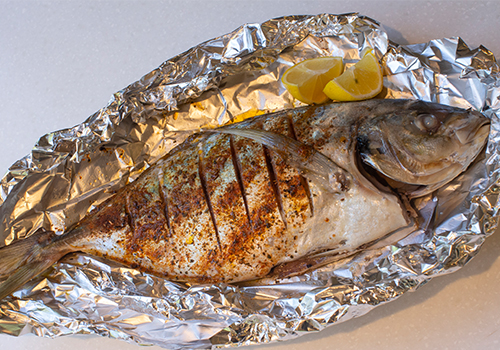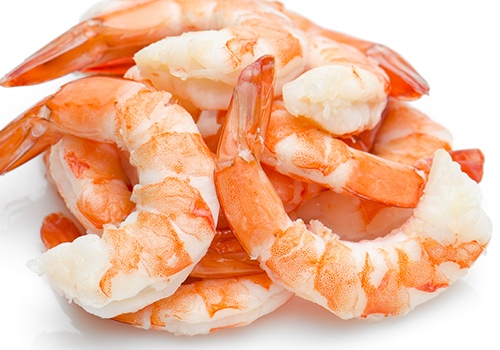Seafood is a Kiwi staple. Whether it’s prawns on the BBQ, a crispy-skinned snapper or a convenient can of tuna, we’re big fans of the delicious proteins that can be found in our oceans. And since New Zealand is surrounded by sea, it’s no surprise that our pantries, fridges and freezers are packed with these sea-based products.
Fresh vs frozen fish
There are so many benefits to eating fish. These delicious swimmers are packed with protein and nutrients. In fact, it’s suggested that eating fish can reduce risks associated with heart disease, lower blood pressure, and reduce inflammation.
You can purchase fresh and frozen fish at your supermarket or your local markets – but which is which?

Fresh fish
Fresh fish has a pretty straightforward meaning: the fish has been caught recently, kept cold, and made its way to your local seafood counter, where it’s now ready for you to select. It might be a wild caught fish, or it might be a farm caught fish. And it might be a whole fish, or it may be presented as fillets. Either way, it’s ready for you to take home, cook and serve. If you’re sold on the idea of your fish being traditionally fresh, check the labels at the seafood counter. Some may actually be previously frozen fresh fish that has been thawed for convenience.
Frozen fish
Frozen usually means rapidly chilled flash frozen fish. Flash freezing (also known as blast freezing) is a super speedy process. As soon as the fish is caught, it is frozen immediately at an extremely low temperature to lock in the flavours, juices and nutrients. The secret to flash freezing is its speed. It doesn’t allow for large ice crystals to form on the seafood’s surface.
When using traditional slow freezing methods, seafood is known to degrade quickly. Large ice crystals will damage the fish’s fibre, making it limp and dried out. The speed of flash freezing means only small ice crystals have the chance to form, giving you the flavoursome and juicy fish that you know and love.
So we’ve broken down the meanings. Now let’s take a closer look at the benefits of buying fresh fish and buying frozen fish.
Benefits of fresh fish
No thawing is needed – this might seem obvious, but it is unquestionably one of the advantages of cooking with fresh fish. If you’re heading to the supermarket looking for ingredients to make healthy homemade takeaways, you’re best to buy fish that you can cook immediately. Cooking with frozen fish requires a bit of forward-thinking as you’ll need to pull it out of the freezer to thaw overnight. Once defrosted, it makes it tricky to change dinner plans too – you can’t freeze it again (this can cause foodborne illnesses), so you have to consume it then or risk waste. With fresh fish, you can buy, cook and enjoy it straight away without any waiting around.
Moisture and nutrition – fish is packed with heart-healthy nutrients, vitamins and minerals. While it’s true that flash freezing locks in all of the goodness, the same can’t always be said for the defrosting process. Some natural water content and nutritional value can be lost, which can result in flesh that may not be as moist after cooking.
Taste – this one is debatable as there is a case for flash frozen fillets being sometimes fresher and tastier– especially if you lived inland 10+ hours from the sea. In New Zealand, we’re pretty lucky to have our fresh fish delivered straight from the trawler to the fishmonger to your kitchen – so you can rest assured the fish you’re purchasing hasn’t been on a truck for the last week. This means that our fresh fish wins the battle of taste. Fillets that were just caught will have the highest quality texture and flavour. The best restaurants in the country only use the freshest fish - and we think you deserve the same!

Benefits of frozen fish
Affordability You’ll often find frozen fish is cheaper because it’s less likely to expire on the shelf. This means you can sometimes buy premium fillets for less simply by shopping from the freezers. Seasonal availability also impacts the price of fresh fish. As there are limited supplies of a species when it’s in season, this drives the price up. Frozen fish tends to have far greater price stability. Frozen can be an excellent option if you’re looking to buy in bulk or save money through food budgeting. It’s a great way to ensure you eat healthy on a budget.
Longevity Since the process of flash freezing will preserve quality in your protein, it increases its longevity. Fresh fish will only last in your fridge for about two days, while frozen fish can stay in your freezer and retain its quality for up to six months.
If you’re looking to save money on groceries, the longevity of frozen fish also allows you to purchase the best deals then cook it once you’re ready.
Consistent quality – as long as frozen fish is frozen quickly using the correct methods and stored properly until consumption, there’s no reason why it shouldn’t retain its maximum freshness. To avoid freezer burn, we recommend looking for vacuum packed varieties and using an airtight container for storage.
Aside from the potential for the fish to lose some of its moisture and nutrition during the thawing process, the quality and most of its nutritional value should be preserved.
Frozen fish is easier to transport safely and less susceptible to bacterial contamination. So you can be confident that the taste and texture of the best quality fish will remain consistent from the fishing boat to your plate.
Fresh v frozen fish – which is the winner?
At the end of the day, there are pros and cons for both fresh and frozen fish. Your choice will ultimately boil down to your lifestyle and your family’s preference as home cooks!
Fresh vs frozen salmon
Farmed or wild salmon is one of the most delicious and nutritious proteins on the planet. It’s high in protein and omega-3 fatty oils and melt-in-your-mouth good. Lucky, we live in a country where it’s so plentiful!

But it’s no secret that salmon can be pricey – so just like other fish, it’s worth considering a frozen option if you happen to be eating or entertaining on a budget.
Here are some tips for buying both fresh and frozen:
- If you’re buying salmon for sushi, make sure you buy the freshest option that’s available, then consume it as soon as possible. Whenever you eat fish raw, there’s a risk of foodborne illness.
- When buying frozen salmon, make sure you check that no ice crystals have formed and there is no freezer burn. Freezer burnt flesh will be visibly lighter coloured and dry around the edges.
- If you want to freeze raw salmon, rinse it, pat it dry, wrap tightly, then place in an airtight container until ready to thaw. Use it within three months for the best quality.
Canned salmon/tuna vs fresh salmon/tuna
We love seafood, but we know how costly it can be. While it would be lovely to eat fresh oysters and caviar for lunch every day, the reality is that most of us can’t afford it!
If you’re looking for affordable food substitutes, canned fish is a great option. Let’s look at some of the benefits of canned salmon vs fresh salmon (and canned tuna vs fresh tuna!).
Benefits of canned fish
Longevity – canned food has a ridiculously long shelf life. That fresh fillet you just bought from the grocery store will only last a few days. But the canning process keeps your canned fish safe for up to four years. Of course, it’s always worth checking the expiry date just to be sure.
Affordability – canned salmon and tuna are far more cost-effective than fresh, with a can only setting you back a few dollars. For example, a 210g can of Pams Pink Salmon will only cost you $3.79; a 200g Bluff Salmon Fillet from the Seafood section will cost you $8.36, more than double the price.
Convenience – one of the greatest appeals of canned foods is that they’re almost always safe to snack on straight from the jar. Any extra cooking is entirely optional – any can will provide a quick ready-made meal! A can of salmon or tuna is also a super convenient protein to add to your meal prep ideas.
Availability – canned tuna and salmon is available year-round, regardless of the season.
Benefits of fresh fish
Nutritional value – fresh fish comes straight from the boat to your fishmonger to your kitchen – so you know it still contains all of its good-for-you nutrients.
When it’s blanched and preserved during the canning process, it may lose some of its nourishing properties.
No additives – many canned foods have higher sodium and sugar contents to preserve the ingredients. Carefully read the can to check for helpful labels like ‘no added salt’ if you want to try and avoid the nasties.
Versatility – there are so many things that you can create with a fillet of fresh fish. It can be barbequed, grilled, oven-baked in moisture proof paper, or even fried with oil in a shallow pan for healthy fish and chips. While there’s certainly plenty you can do with canned seafood, it has more limitations.
Variety – Cod, snapper, hoki, halibut, gurnard, and tarakihi are just a few of the fish available in NZ along with salmon and tuna – unlike canned fish which traditionally only offers a handful of options.
Fresh vs frozen seafood
If you’re thinking of expanding your seafood horizons from your usual fillets of fish, consider New Zealand’s abundance of fresh seafood. We’re known for our love of shellfish, limpets and all kinds of delectable seafood delicacies.
But what about frozen seafood? If you head to the freezers at your local grocery store and you’ll frozen shrimps, prawns, and squid, all ready for you to experiment with for your newest meal creation.
Good news – the same rules apply to seafood as fish. In a nutshell, fresh or frozen are both equally good. The choice is completely up to you!
Looking for more savings tips? Check out our great meat buying guides:
